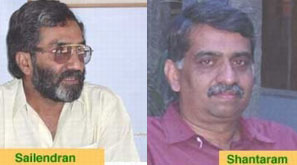There is no cause to imagine that the satellite schools are a life apart from the Rishi Valley School. To persist with the banyan metaphor, the original 300 acres in which the tree stands, having extended to 450, vines have struck root over a 25 km radius in which the satellite schools are located. Around each rural school active village communities have formed. Nalini and Jayant are propagating the value of cultivating herbs and medicinal plants, for health, nutrition, and also for income generation. Sailendran regularly leads teams of students from Rishi Valley to interact with the villages and help them plant their community gardens. Sailendran says, "We discovered how much more profitable is cultivation of Jamun and Custard Apple trees. Villagers get tempted by exotic cropping ideas and forget old native trees." New groups of enthusiasts have formed around Madanapalle inspired by the now green south hills. Sailendran counsels them and arranges for planting materials. Kartik and Vidya run a dispensary at Rishi Valley and also tour the villages. "Most of the ailments are due to poor nutrition. Tuberculosis is only a layer away," he says. He is creating a database to map the health profile of the villages. With Nalini's help he is prescribing diets that include leaves and grains, now fallen in people's esteem. You can discern a convergence of all these seemingly unrelated initiatives. The focus of Rishi Valley School's work with rural people is on restoring their pride in their own worth. The purpose of education ought not to be in preparing people to be cogs in the modern economic machine, but to teach them to live sustainably, profitably, proudly, creatively, supportively whatever their habitats.

Under the old banyan:
Personal commitments had taken Rangaswami away from the campus for 12 years. By the time he returned in 1990, Naidu's labours had wrought a magic. There was a distinct increase in species of birds. He and Shantaram paired up and did an ornithological survey. The score: 205 species, up from the historical maximum of 80. It was time therefore in 1991, to declare that Rishi Valley was officially a 'Private Bird Preserve'. There is a picture of Rangaswami standing under the banyan, reading the declaration. Radhika is looking on with contentment writ large on her face. She had been the unobtrusive, encouraging force behind the School's expansion in many directions.
The air about the School is one of understated passion. Every idea that is in furtherance of nature's success, is pursued. Shantaram takes his task of being the Associate Warden of the Preserve very seriously. He and Rangaswami run the Institute of Bird Studies and Natural History, they started in 1997. They offer a correspondence course in ornithology which is growing popular, with over 600 people across the country having completed it. Naidu though retired now, keeps returning to his beloved campus. The Raos together were elected Ashoka Fellows for their work in education. Nalini has laid a herbal garden for President A P J Kalam at the Rashtrapati Bhavan. Clearly, the School's creative stream is in flow.
